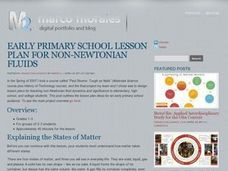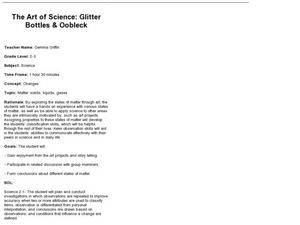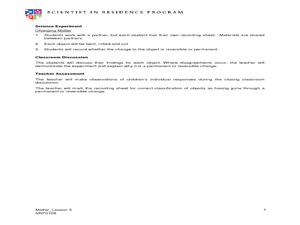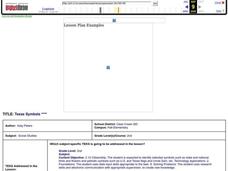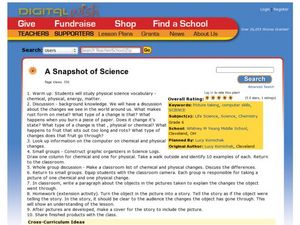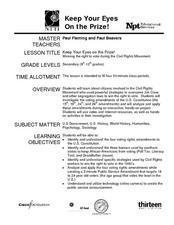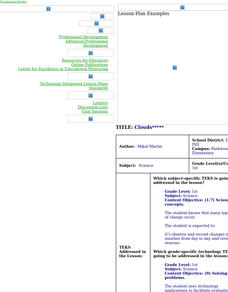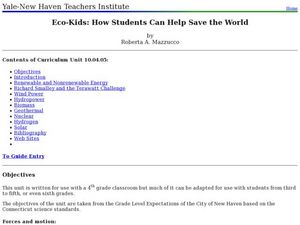Curated OER
States of Matter Lesson
Second graders identify the three phases of matter and demonstrate how a property can change states of matter. In this states of matter lesson, 2nd graders make an Ooze to discover how a solid changes into a liquid. Students...
Curated OER
The Three States of Matter
Students explore the three states of matter. In this physics lesson, students are shown examples of solids, liquids, and gases. Students make cookies and identify the three states of matter during the baking process.
Curated OER
Non-Newtonian Fluids
Students will use water, cornstarch, eggs, and more to explore the different states of matter. They will make observations of an unknown substance called "Oobleck" and test its liquid and solid properties. This would be a great...
Curated OER
The Art of Science: Glitter Bottles and Oobleck
After having a class discussion on the three states of matter, young scientists utilize the wonderful substance, Oobleck in order to experience something that changes states of matter. They also create "sparkle jars" which...
Curated OER
Mixing It Up!
Third graders identify the different states of matter. In this science lesson, 3rd graders describe the different components of solutions and mixtures. They create emulsions, foams and suspensions in the lab.
Curated OER
Physical Changes to Matter
Pupils explore matter by conducting an in-class experiment. They experiment with water's various forms by melting and freezing water, identifying its new shape. These observations are recorded to supplement later discussion. They also...
Curated OER
Chemical Wonders
Students read about and discuss how chemical engineers use different states of matter to create substances. In this chemical engineering lesson plan, students also give examples of the 3 kinds of matter.
Curated OER
The Water Cycle: States of Water
Elementary schoolers explore states of matter by concentrating on the ways in which water moves between its solid, liquid, and gaseous states in a variety of Earth environments. Learners interpret these movements through dance. The...
Curated OER
States
Second graders look up their assigned states on the internet, cut and paste pictures on word document, and print out the pictures.
Curated OER
The Water Cycle: Revising the Drafts
Young scholars explore states of matter by concentrating on the ways in which water moves between its solid, liquid, and gaseous states in a variety of Earth environments familiar to the students. Young scholars represent these movements...
Curated OER
Texas Symbols
Second graders identify the Texas symbols, collect information from the Internet about one of the state's symbols, and present the information they collected in KidPix. Can be adapted to any state.
Curated OER
The Cold War Warrior Defending: The Moral Beacon of the World
High schoolers identify President Reagan's domestic and foreign policy, describe America's attitude toward communism, list characteristics which endeared Reagan to the American people, and explain why some Americans spoke out against...
Curated OER
A Snapshot of Science
Sixth graders explore physical and chemical changes. In this physical science lesson, 6th graders study vocabulary, discuss the changes they see in the world and look up information on chemical and physical changes. Students create...
Curated OER
Primary Sources and Protagonists: A Native American Literature Unit
Introduce your middle schoolers to the lives of past Native Americans. First, learners work together to put photographs in a sequence. Then, using their sequence, they create stories to share with the whole class. No matter how old your...
Curated OER
Wonderful Water
Students identify the various states of water and its natural flow downward. As a class, students take digital pictures of different forms of water and create a multimedia presentation describing their photographs. Groups of students...
Curated OER
Flower Symbolism
Fourth graders identify flowers as symbols in art forms. They focus on the Victorian era and create their own flower design for use in visual art or literary forms.
Curated OER
Keep Your Eye On the Prize
High schoolers learn about citizens who were actively involved in the civil rights movement, and the strategies they used to overcome the Jim Crow laws that were so prevalent in the 1960s. They investigate the voting amendments of the US...
Curated OER
Clouds
First graders create a PowerPoint presentation and identify three types of clouds; cirrus, stratus and cumulus. In addition, 1st graders construct their own type of cloud during a hands-on activity.
Curated OER
See Spot Run
Students identify several properties of water as a universal substance, describe the composition of several complex color mixtures and separate the components of dye using chromatographic technique.
Curated OER
Sing Out Loud: The Slave Spirituals Historical and Cultural Implications during Reconstruction
Students identify, summarize and present facts about cultural, educational and political inequalities of Reconstruction, explain hidden codes of slave spirituals and their importance in slaves' communication, and create poetry based on...
Curated OER
Airing Our concerns: I Can See Clearly Now
Learners research specific answers to questions about air pollution. In this air pollution lesson, students share information to fully understand the causes of air pollution. Learners role play individuals from different groups to...
Curated OER
Impact Craters: Holes in the Ground!
Students simulate crater formation through a lab activity. In this space science lesson, students calculate how much energy is transferred during meteorite impact. They identify different factors affecting the size and depth of craters...
Curated OER
Eco-Kids: How Students Can Help Save the World
Fourth graders identify the different types of renewable and nonrenewable energy sources. In this ecology lesson plan, 4th graders create models of wind mills and hydropower. They discuss the pros and cons of using alternative forms of...
Curated OER
Sorting and Using Materials
Students explore materials and their properties. In this matter lesson, students identify objects and describe their properties. Students test and sort materials using an interactive whiteboard, followed by a group discussion of what was...


